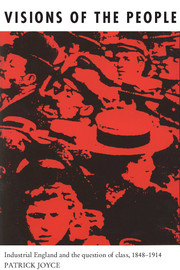Book contents
- Frontmatter
- Contents
- List of plates
- Acknowledgements
- 1 Introduction: beyond class?
- PART I POWER AND THE PEOPLE: POLITICS AND THE SOCIAL ORDER
- PART II MORALISING THE MARKET: WORK AND THE SOCIAL ORDER
- PART III CUSTOM, HISTORY, LANGUAGE: POPULAR CULTURE AND THE SOCIAL ORDER
- PART IV KINGDOMS OF THE MIND: THE IMAGINARY CONSTITUTION OF THE SOCIAL ORDER
- 9 Investigating popular art
- 10 The broadside ballad
- 11 The voice of the people? The character and development of dialect literature
- 12 Dialect and the making of social identity
- 13 Stages of class: popular theatre and the geography of belonging
- 14 Summary and conclusion: the making of the English working class before 1914?
- Appendices
- Bibliographical note
- Notes
- Index
12 - Dialect and the making of social identity
Published online by Cambridge University Press: 05 March 2012
- Frontmatter
- Contents
- List of plates
- Acknowledgements
- 1 Introduction: beyond class?
- PART I POWER AND THE PEOPLE: POLITICS AND THE SOCIAL ORDER
- PART II MORALISING THE MARKET: WORK AND THE SOCIAL ORDER
- PART III CUSTOM, HISTORY, LANGUAGE: POPULAR CULTURE AND THE SOCIAL ORDER
- PART IV KINGDOMS OF THE MIND: THE IMAGINARY CONSTITUTION OF THE SOCIAL ORDER
- 9 Investigating popular art
- 10 The broadside ballad
- 11 The voice of the people? The character and development of dialect literature
- 12 Dialect and the making of social identity
- 13 Stages of class: popular theatre and the geography of belonging
- 14 Summary and conclusion: the making of the English working class before 1914?
- Appendices
- Bibliographical note
- Notes
- Index
Summary
This chapter is about the effort to create identity; as Reddy puts it, the rhetorical attempt to ‘make, mould and alter’ community identities. Language mattered in this. It mattered in quite central ways, ways embedded in the nature of culture itself, and broached already in the previous discussion of custom, its desuetude and its reproduction. Language was the bearer of values and ideas, in stories and proverbs, for example. But it was more than merely a bearer or vehicle: it was in fact the embodiment or substance of values, itself a form of symbolic meaning standing for all manner of desires, associations, beliefs, conscious and unconscious. Dialect literature was thus embedded in the linguistic nature of culture itself and took its strength from this. That is one reason why it is such an important expression of popular culture. But it also represented a conscious articulation of desires and associations: working people deliberately identified their language as the central symbol of their culture and set out to elaborate this identification in the large number of ways making up the corpus of dialect literature.
Comparison with the French example of nineteenth-century textile workers studied by Reddy serves to delineate the English example. What Reddy has to say about language and the formation of social identities applies with equal force to the English case, though there were significant differences between the two, not least the much greater scope and complexity of English dialect.
- Type
- Chapter
- Information
- Visions of the PeopleIndustrial England and the Question of Class, c.1848–1914, pp. 279 - 304Publisher: Cambridge University PressPrint publication year: 1991



